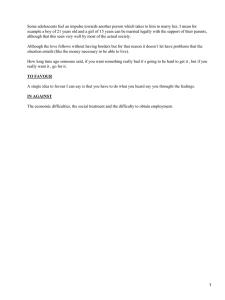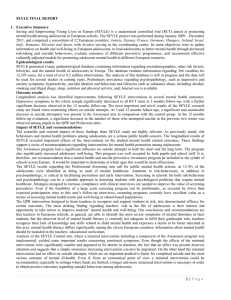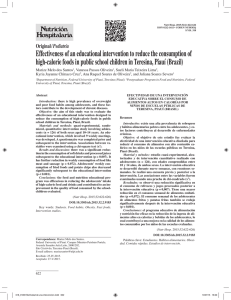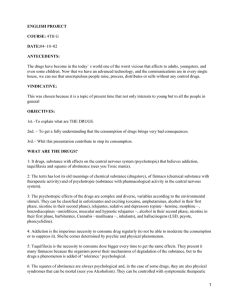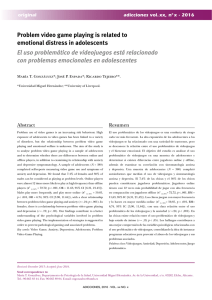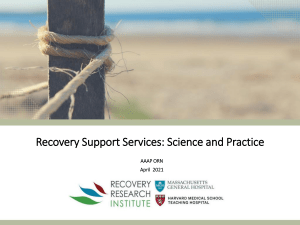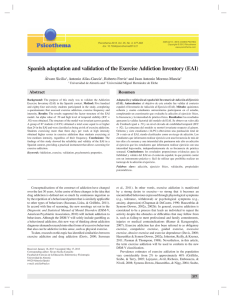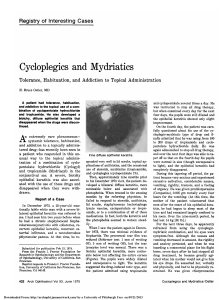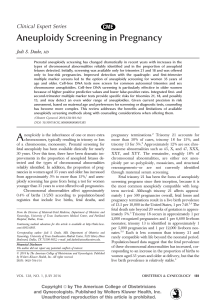Evaluation and early detection of problematic Internet use in
Anuncio
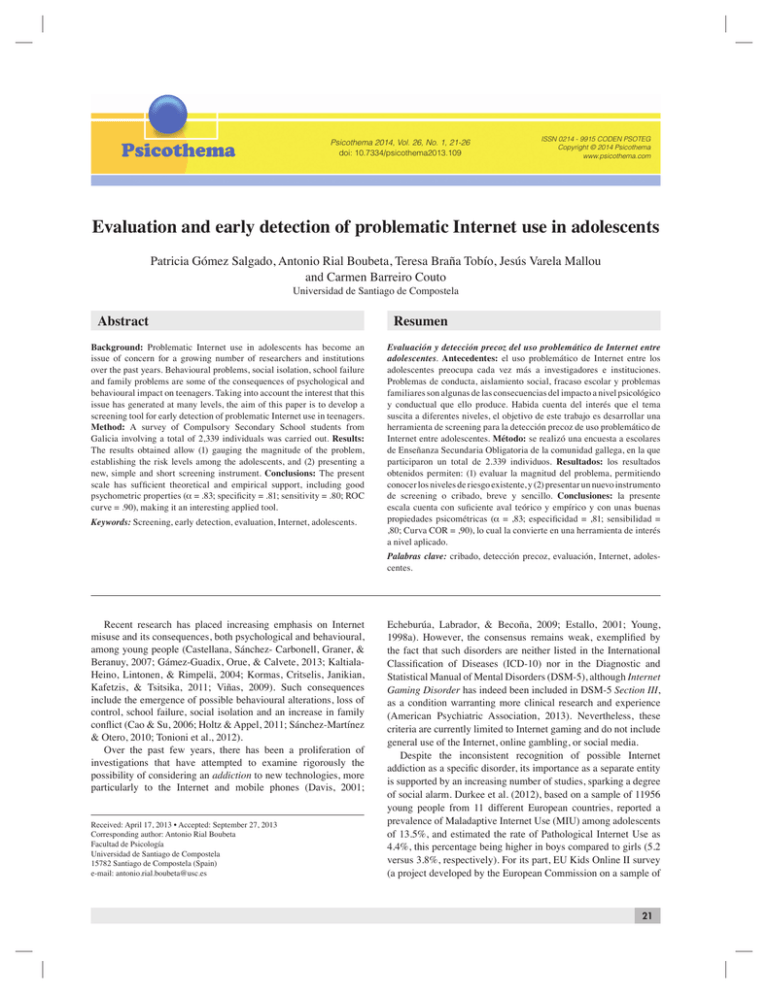
Psicothema 2014, Vol. 26, No. 1, 21-26 doi: 10.7334/psicothema2013.109 ISSN 0214 - 9915 CODEN PSOTEG Copyright © 2014 Psicothema www.psicothema.com Evaluation and early detection of problematic Internet use in adolescents Patricia Gómez Salgado, Antonio Rial Boubeta, Teresa Braña Tobío, Jesús Varela Mallou and Carmen Barreiro Couto Universidad de Santiago de Compostela Abstract Background: Problematic Internet use in adolescents has become an issue of concern for a growing number of researchers and institutions over the past years. Behavioural problems, social isolation, school failure and family problems are some of the consequences of psychological and behavioural impact on teenagers. Taking into account the interest that this issue has generated at many levels, the aim of this paper is to develop a screening tool for early detection of problematic Internet use in teenagers. Method: A survey of Compulsory Secondary School students from Galicia involving a total of 2,339 individuals was carried out. Results: The results obtained allow (1) gauging the magnitude of the problem, establishing the risk levels among the adolescents, and (2) presenting a new, simple and short screening instrument. Conclusions: The present scale has sufficient theoretical and empirical support, including good psychometric properties (α = .83; specificity = .81; sensitivity = .80; ROC curve = .90), making it an interesting applied tool. Keywords: Screening, early detection, evaluation, Internet, adolescents. Resumen Evaluación y detección precoz del uso problemático de Internet entre adolescentes. Antecedentes: el uso problemático de Internet entre los adolescentes preocupa cada vez más a investigadores e instituciones. Problemas de conducta, aislamiento social, fracaso escolar y problemas familiares son algunas de las consecuencias del impacto a nivel psicológico y conductual que ello produce. Habida cuenta del interés que el tema suscita a diferentes niveles, el objetivo de este trabajo es desarrollar una herramienta de screening para la detección precoz de uso problemático de Internet entre adolescentes. Método: se realizó una encuesta a escolares de Enseñanza Secundaria Obligatoria de la comunidad gallega, en la que participaron un total de 2.339 individuos. Resultados: los resultados obtenidos permiten: (1) evaluar la magnitud del problema, permitiendo conocer los niveles de riesgo existente, y (2) presentar un nuevo instrumento de screening o cribado, breve y sencillo. Conclusiones: la presente escala cuenta con suficiente aval teórico y empírico y con unas buenas propiedades psicométricas (α = ,83; especificidad = ,81; sensibilidad = ,80; Curva COR = ,90), lo cual la convierte en una herramienta de interés a nivel aplicado. Palabras clave: cribado, detección precoz, evaluación, Internet, adolescentes. Recent research has placed increasing emphasis on Internet misuse and its consequences, both psychological and behavioural, among young people (Castellana, Sánchez- Carbonell, Graner, & Beranuy, 2007; Gámez-Guadix, Orue, & Calvete, 2013; KaltialaHeino, Lintonen, & Rimpelä, 2004; Kormas, Critselis, Janikian, Kafetzis, & Tsitsika, 2011; Viñas, 2009). Such consequences include the emergence of possible behavioural alterations, loss of control, school failure, social isolation and an increase in family conflict (Cao & Su, 2006; Holtz & Appel, 2011; Sánchez-Martínez & Otero, 2010; Tonioni et al., 2012). Over the past few years, there has been a proliferation of investigations that have attempted to examine rigorously the possibility of considering an addiction to new technologies, more particularly to the Internet and mobile phones (Davis, 2001; Received: April 17, 2013 • Accepted: September 27, 2013 Corresponding author: Antonio Rial Boubeta Facultad de Psicología Universidad de Santiago de Compostela 15782 Santiago de Compostela (Spain) e-mail: antonio.rial.boubeta@usc.es Echeburúa, Labrador, & Becoña, 2009; Estallo, 2001; Young, 1998a). However, the consensus remains weak, exemplified by the fact that such disorders are neither listed in the International Classification of Diseases (ICD-10) nor in the Diagnostic and Statistical Manual of Mental Disorders (DSM-5), although Internet Gaming Disorder has indeed been included in DSM-5 Section III, as a condition warranting more clinical research and experience (American Psychiatric Association, 2013). Nevertheless, these criteria are currently limited to Internet gaming and do not include general use of the Internet, online gambling, or social media. Despite the inconsistent recognition of possible Internet addiction as a specific disorder, its importance as a separate entity is supported by an increasing number of studies, sparking a degree of social alarm. Durkee et al. (2012), based on a sample of 11956 young people from 11 different European countries, reported a prevalence of Maladaptive Internet Use (MIU) among adolescents of 13.5%, and estimated the rate of Pathological Internet Use as 4.4%, this percentage being higher in boys compared to girls (5.2 versus 3.8%, respectively). For its part, EU Kids Online II survey (a project developed by the European Commission on a sample of 21 Patricia Gómez Salgado, Antonio Rial Boubeta, Teresa Braña Tobío, Jesús Varela Mallou and Carmen Barreiro Couto 25142 children from 25 European Countries) has shown that 30% of 11-16 year-old-children have experienced one or more forms of excessive Internet use «fairly» or «very often» (Livingstone, Haddon, Görzig, & Ólafsson, 2011). Furthermore, the results from EU NET ADB (a research project funded by the European Commission’s Safer Internet Programme) have recently been published. Based on a representative sample of 13,284 adolescents aged 14-17 from 7 European countries, this study reported that 1.2% of the total sample present Internet addictive behaviour (IAB), while 12.7% are said to be at risk (Tsitsika, Tzavela, Mavromati, & the EU NET ADB Consortium, 2012). In Spain, several studies have reported different prevalence rates for young people: from 3.7% of problematic Internet use in adolescents aged 14-18 from Madrid (Estévez, Bayón, de la Cruz, & Fernández-Líria, 2009), to 9.9% of excessive users among university students (Muñoz-Rivas, Fernández, & Gámez-Guadix, 2010). Other researchers suggested intermediate values, such as the 5% of Internet overusers referred by Viñas et al. (2002), the 6.1% with frequent problems because of their Internet use found by Carbonell et al. (2012) or the 6.2% of pathological users found by Jenaro, Flores, Gómez-Vela, González-Gil, & Caballo (2007). In spite of the considerable knowledge now available, it is difficult to integrate the different studies’ results and to properly diagnose the current situation. It is not currently possible to reach an agreement on which is the proper term to describe the problem. As stated in the study of Gámez-Guadix et al. (2013), this pattern has been called Compulsive Use, Problematic Internet Use, Internet Addiction, Maladaptive Internet Use or Pathological Internet Use. Although these terms are often used interchangeably, there is still significant controversy, so, in our view, the term used in each case should be chosen with caution. The influence of distinct sample sizes used, the different reference population, the dissimilar procedures of data collection, and the lack of agreed criteria about what should be considered addiction or not has resulted in a high level of confusion. The multiplicity of evaluation instruments used is also another issue that needs to be resolved (Beranuy, Chamarro, Graner, & Carbonell, 2009; Ceyhan, Ceyhan, & Gûrcan, 2007; De Gracia, Vigo, Fernández, & Marcó, 2002; Young, 1998a; Young, 1998b). Many of the scales developed so far have problems: (a) they are not all specific for adolescent population or their items do not correspond to teenager’s reality (Armstrong, Phillips, & Saling, 2000; Nichols & Nicki, 2004); (b) they do not provide data on their psychometric properties (Echeburúa et al., 2009); (c) the size of the samples used for empirical validation is small (Lam-Figueroa et al., 2011); (d) it would be difficult to use them as screening tools given their high number of items (Davis, Flett, & Besser, 2002; García del Castillo et al., 2008), or because they do not provide cut-off points, neither sensitivity and specificity values (Gámez-Guadix et al., 2013; Meerkerk, Van Den Eijnden, Vermulst, & Garretsen, 2009); (e) there are no Spanish versions (Demetrovics, Szeredi, & Rózsa, 2008); and (f) the cultural environment where they were developed seems to have very little to do with Spanish culture (Huang, Wang, Qian, Zhong, & Tao, 2007; Lin & Tsai, 2002). In short, the research that has been carried out to date with its accompanying abundant literature is contrasted by the lack of agreement on both the conceptualization and evaluation of problematic Internet use. Moreover, some researchers, such as Aboujaoude (2010), have suggested that many of the existing scales have not received adequate psychometric testing. 22 The present study therefore has a markedly applied objective being the development of an early detection tool of problematic Internet use in adolescents, understanding this as a maladaptive behaviour pattern with interferences in daily life. This instrument must be backed by sufficient theoretical support (integrating the different scales and contributions collected in the literature), based on empirical evidence, and have acceptable psychometric properties, both in terms of reliability, validity, sensitivity and specificity. Furthermore, the study aimed to generate a useful instrument on a practical level, with particular emphasis on conciseness, easy applicability and to contain items appropriate to the adolescent population, and to Spanish culture. Such a new instrument will constitute a benefit in two ways: on the one hand, it will provide data to gauge the magnitude of the problem, reporting existing risk levels, and on the other hand, it will promote early detection or screening of potential risk cases. Method Participants In pursuit of its purpose, a selective methodology and a cross design were used, carrying out a survey of the Compulsory Secondary Education students from Galicia. For the sample selection, two-stage sampling was used: by cluster sampling, for the selection of the first-level units (secondary schools), and by quotas of Gender and Grade, for the selection of the second-level units (individuals). For data collection, a total of 29 secondary schools, public as well as private/subsidized, were randomly selected, in both urban and rural area and from the four Galician provinces, respecting population quotas. The final sample consisted of 2,339 Compulsory Secondary Education students from Galicia, 1,171 girls and 1,168 boys, between the ages of 11 and 18 (M = 13.77, SD = 1.34). Of these, 1,619 attended public schools and 720 attended private or subsidized schools; 1,239 studied in lower secondary education (1st and 2nd grade) and 1,100 were in upper secondary education (3rd and 4th grade). Instruments Data collection was undertaken through the application of a questionnaire (developed for a broader study) which included a screening scale of problematic Internet use, comprising 9 Likerttype items, with five answer options ranging from 0 “Strongly disagree” to 4 “Strongly agree”, extracted from the review of the literature (see Table 1). For the selection of the items, particular attention has been paid to their theoretical and empirical support and, at the same time, to the possibility of using them for screening problematic Internet use, taking into account some of the Internet Gaming Disorder criteria (symptoms of withdrawal, endangering their academic functioning…). Procedure Data was collected in their own classrooms, in small groups (no more than 20 individuals), after prior detailed explanation of the corresponding instructions. The information was collected by a group of researchers from the University of Santiago de Compostela with extensive experience in carrying out this type of work. Participants were informed about the purpose of the Evaluation and early detection of problematic Internet use in adolescents Table 1 Items of the initial screening scale and sources Items Sources 1. Para mí es importante poder conectarme diariamente a Facebook, Tuenti… [It is important for me to connect daily to Facebook, Tuenti…] Davis et al., 2002 2. En algunas ocasiones he perdido horas de sueño por usar Internet [Sometimes I have lost hours of sleep due to Internet use] Armstrong et al., 2000 Chen, Weng, Su, Wu, & Yang, 2003 Demetrovics et al., 2008 García del Castillo et al., 2008 Huang et al., 2007 Young, 1998a 3. A veces me conecto más de lo que debiera [Sometimes I get online more than I should] Davis et al., 2002 Echeburúa et al., 2009 4. En ocasiones prefiero quedarme conectado/a a Internet en lugar de estar con mi familia o amigos/as [At times, I prefer to stay connected to the Internet instead of being with my family or friends] Chen et al., 2003 García del Castillo et al., 2008 Young, 1998b 5. En ocasiones me pongo de mal humor por no poder conectarme [At times, I get in a bad mood because of not being able to connect to the Internet] Demetrovics et al., 2008 García del Castillo et al., 2008 Lam-Figueroa et al., 2011 Young, 1998b 6. Cuando estoy conectado/a siento que el tiempo vuela y cuando me doy cuenta llevo horas en Internet [When I am online, I feel time flies, and when I realise I have been on the Internet for hours] Beranuy et al., 2009 Huang et al., 2007 7. He descuidado mis tareas escolares por conectarme a Internet [I have neglected my homework due to Internet use] Beranuy et al., 2009 Chow, Leung, Ng, & Yu, 2009 De Gracia et al., 2002 García del Castillo et al., 2008 Huang et al., 2007 Young, 1998a 8. He dejado de hacer cosas importantes para estar conectado/a [I have stopped doing important things to get connected] Beranuy et al., 2009 De Gracia et al., 2002 Echeburúa et al., 2009 9. A veces me siento más cómodo chateando por Facebook, Tuenti… que hablando cara a cara con la gente [Sometimes I feel more comfortable chatting on Facebook, Tuenti… than talking face to face with people] Beranuy et al., 2009 Caplan, 2002 García del Castillo et al., 2008 study, and repeatedly assured of the complete anonymity and confidentiality of their responses. This study was carried out with the consent and cooperation from both the school leadership and respective parents’ associations, and the participation was entirely voluntary. Results Firstly, with regard to Internet use habits, it is worth emphasizing that 60.4% of teenagers affirmed they accessed the Internet every day or almost every day. In addition, 26.8% connected to the Internet occasionally (once or twice a week). A large proportion of adolescents were usually connected between 1 and 2 hours a day (45.8%), although 10.5% acknowledged they spent more than 3 hours a day. The time slot 16.00-21.00 was the most usual time zone of Internet connection (56.8%), although 39.2% of teenagers were connected between 21.00-00.00 as well, and almost 6% from midnight. 36.2% of the interviewees stated that they are not on Internet all the time they would like. Another interesting fact is that 55% of adolescents had Internet access in their own room, and 15.8% used their mobile phone to navigate the Internet. With regard to the role of parents, it should be noted that 54% of the interviewees said their parents do not control their Internet use at all. Furthermore, 77.9% of young Internet users had rarely or never had an argument with their parents due to their Internet use, whereas 6.3% declared having problems many times, and 14.6% occasionally. Finally, in relation to some potentially dangerous uses, 64.3% of adolescents usually downloaded music, movies, photos… from the Internet, 40.2% usually uploaded photos to Facebook or Tuenti, and 20.4% admitted that they visit some age-inappropriate webpages. With regard to the testing of the scale itself, Table 2 shows descriptive statistics for each of the 9 initial version items. The highest averages corresponded to item 6 (When I am online, I feel time flies, and I realise I have been on the Internet for hours), and item 1 (It is important for me to connect daily to Facebook, Tuenti…), scoring 2.39 and 2.27, respectively. Meanwhile, the lowest average corresponded to item 4 (At times, I prefer to stay connected to the Internet instead of being with my family or friends), scoring 0.95. Related to the variability of response, item 9 (Sometimes I feel more comfortable chatting on Facebook, Tuenti… than talking face to face with people) had the most heterogeneous answers (SD = 1.47), although there were no large differences across items. In connection with frequency distribution, items 2, 4, 5, 7, 8 and 9 had positive standardized skewness values, while items 1 and 6 had a strong negative skewness, with absolute values greater than 3. Regarding kurtosis, many of the items showed a platykurtic distribution. Mardia’s coefficient was 22.07, indicating no multivariate normality. Table 2 Descriptive statistics of the initial screening scale Data analysis M Descriptive statistics (M, SD, skewness and kurtosis indexes) were calculated to study item distribution at a univariate level, and multivariate normality was tested via Mardia’s coefficient. A Confirmatory Factor Analysis (CFA) was conducted to study the factorial structure of the scale, and maximum likelihood (ML) was the chosen method. Cronbach’s alphas were estimated to assess internal consistency. In addition, a specificity and sensitivity analysis, and a Receiver Operating Characteristic (ROC) Curve analysis were included. All statistical analyses were carried out by using the IBM SPSS Statistics 20 and IBM SPSS Amos 20. SD Skewness Kurtosis CHI .49 Item 1 2.27 1.38 0-4.12 -10.36 Item 2 1.10 1.45 -17.57 0-5.36 .59 Item 3 2.02 1.46 0-0.12 -12.53 .53 Item 4 0.95 1.23 -21.77 -0 3.32 .53 Item 5 1.42 1.43 -10.71 0-9.29 .61 Item 6 2.39 1.42 0-5.66 -11.22 .49 Item 7 1.03 1.29 -18.98 0-1.11 .58 Item 8 1.05 1.28 -19.21 0-0.19 .63 Item 9 1.56 1.47 -0 7.71 -11.27 .38 23 Patricia Gómez Salgado, Antonio Rial Boubeta, Teresa Braña Tobío, Jesús Varela Mallou and Carmen Barreiro Couto In order to analyze the relationship of each item to the whole scale, Corrected Homogeneity Index (CHI) was calculated, obtaining values between .49 and .65 for all items, except item 9 for which the CHI was .38. The internal consistency of this initial version was calculated by Cronbach’s coefficient alpha. The total value obtained was very acceptable (.84). The responses were subjected to factor analysis to examine the psychometric properties of the screening scale of problematic Internet use. A CFA was conducted to confirm one-dimensional factorial structure proposed by Young (1998b). Parameters were estimated using ML, given that studies such as those performed by Curran, West, & Finch (1996) and Tomás & Oliver (1998) have shown that maximum likelihood is robust against violations of normality when samples are large, and in any case, a worse data fit than real one would be provided. Every estimated parameter (see Figure 1) was statistically significant (p<.01), and factor loadings (λ) showed high values, except in the case of item 9. Goodness-of-fit was assessed using different indicators, as recommended by researchers such as Byrne (2009) or Kline (2005): χ2, χ2/degrees of freedom, Goodness of Fit Index (GFI), Adjusted Goodness of Fit Index (AGFI), Comparative Fit Index (CFI), Normed Fit Index (NFI), Tucker Lewis Index (TLI) and Root Mean Square Error of Approximation (RMSEA). The results from the different fit indices used seemed to show that the scale fits moderately well to the theoretical model (see Table 3). The values of GFI, AGFI, CFI and NFI were higher than .90, the TLI was .89, and the RMSEA (.089) was higher than the reference value recommended by Hu & Bentler (1999). Because of its low CHI (.38) and its low factor loading in CFA (.41), item 9 was removed. Furthermore, a detailed analysis of modification indices suggested to take into account two specific parameters related to the measurement error correlations between item 3 and 6 (δ3-δ6), and item 7 and 8 (δ7-δ8). In order to test the stability of the respecified model, a cross-validation attempt was carried out. The original database was divided randomly into two different subsamples and the same statistical procedure was applied to compare both subgroups. Empirically corroborated goodness-of-fit indices for the model were high and very similar in both halves (see Table 3). The values of GFI, AGFI, CFI, NFI and TLI were higher than .95, and the RMSEA didn’t exceed .08. Furthermore, estimated parameters were similar in both random subsamples (Figure 2 and 3) and measurement error correlations (δ3-δ6 and δ7-δ8) were statistically significant as well. Finally, the internal consistency of the scale was reanalyzed, obtaining a very acceptable index (α = .83). The goodness-of-fit of the model have been substantially improved (see Table 3). With respect to the descriptive statistics of the total sample, taking into account that the 8-item final scale has a theoretical minimum score of 0 and a maximum of 32 points, the mean was 12.22 and the standard deviation was 7.44. Finally, as there are no consensus diagnostic criteria yet to identify a clinical sample, and in order to try to explore its screening ,18 ,33 e1 l1 ,53 e2 l2 ,63 e3 l3 ,52 e4 l4 ,60 e5 l5 e6 l6 ,61 e7 l7 ,67 e8 l8 ,53 e1 l1 e2 l2 ,67 e3 l3 ,58 e1 l1 ,53 ,60 e2 l2 ,72 e3 l3 ,60 e4 l4 e4 l4 ,51 Figure 2. Confirmatory factor analysis: Final Structural Model (Half 1) SCALE ,66 e5 l5 e6 l6 e7 l7 e8 l8 ,53 e9 SCALE ,68 ,20 ,69 ,74 ,41 ,25 l9 Figure 1. Confirmatory factor analysis: Initial Structural Model ,60 SCALE ,68 e5 l5 e6 l6 ,67 e7 l7 ,72 e8 l8 ,50 Figure 3. Confirmatory factor analysis: Final Structural Model (Half 2) Table 3 Confirmatory factor analysis, model fit indices χ2 gl p χ2/gl GFI AGFI CFI NFI TLI RMSEA [CI]* Initial model 451.16 27 <.001 16.71 .94 .91 .91 .91 .89 .089 [.082-.096] Respecified model (Half 1) 125.66 18 <.001 06.98 .97 .94 .95 .94 .92 .077 [.065-.090] Respecified model (Half 2) 106.44 18 <.001 05.91 .97 .95 .96 .96 .94 .070 [.058-.083] * 90% Confidence interval for RMSEA 24 Evaluation and early detection of problematic Internet use in adolescents capacity, the available sample was divided into two groups: (a) a first one that could be considered “Normal group” and (b) a second one that could be considered “Risk group”, consisting of the individuals who connect to the Internet every day, usually more than five hours per day, and have frequent arguments with their parents for this reason. The sensitivity and specificity obtained for different cut-off points are shown in Figure 4. As can be noted, values 18 and 19 achieved the best balance between both indicators. For a score of 19, a sensitivity of 80% and a specificity of 81.2% were obtained, which means the scale would be able to detect 80% of true positives and to reject 81.2% of true negatives. In addition a Receiver Operating Characteristic (ROC) curve analysis was performed to determine optimal cut-off value, obtaining an area under the curve of .90 (see Figure 5). Taking as a cut-off point a score of 19, and applying the screening scale to the available sample, this would mean that 19.9% of Galician adolescents would be classified as potentially problematic Internet users. 100 90 80 70 60 50 40 30 20 10 0 94.3 94.3 91.4 91.4 85.7 80 78 74.1 70 65 81.2 60.5 Its application on a representative sample of Compulsory Secondary School students from Galicia revealed that 19.9% of adolescents would be problematic Internet users. Similar prevalence estimates of Maladaptive Internet Use in adolescents (MIU = 13.5%) and Pathological Internet Use (PIU = 4.4%) were recently reported by Durkee et al. (2012). Therefore, our results provide the concerning suggestion that at least 15,000 Galician adolescents are “at risk”, strongly reinforcing the need to implement preventive measures. We are aware of the limitations of this study and we therefore emphasise that it should be considered as an empirical approach the primary purpose of which was to contribute to improved knowledge of the problem and to its evaluation. It is impossible to access clinical samples to test the scale properties because of lack of clinical consensus on diagnostic criteria and no official recognition yet of Internet addiction. However, the fact remains that the scientific community, institutions, and society as a whole are demanding a proactive approach and attitude towards a situation that could become a real problem. This work should be considered a starting point to further address adolescent Internet use in a serious and rigorous way. Future research will lead to an improvement of the developed screening scale and to its clinical validation. In this regard, one of the greatest challenges in this research field is to achieve consensus on what to call (Compulsive Use, Problematic Internet Use, Internet Addiction…) and how conceptualize this pattern, identifying the criteria to use in evaluating. Otherwise the comparison among different studies will remain impossible. 1,0 14 15 16 Sensitivity 17 18 19 Specificity 0,8 Discussion The current study was designed to develop a screening or early detection tool of problematic Internet use in adolescents. Based on analyses carried out from a sample of 2,339 students from Galicia, a short scale (8 items) developed from the main previous tests (Beranuy et al., 2009; Davis et al., 2002; Echeburúa et al., 2009; García del Castillo et al., 2008; Young, 1998a; Young, 1998b) is presented as a screening instrument with acceptable psychometric properties, in terms of reliability, validity, sensitivity and specificity. This simple and easy to apply tool is adapted to the Spanish cultural context and to the youth language, which means it has a great practical potential. As a screening tool, its use enables the gradation of adolescents on a risk continuum, but it is not diagnostic due to the lack of agreed established criteria and the necessary clinical assessment. Sensitivity Figure 4. Sensitivity and Specificity values for different cut-off points 0,6 0,4 0,2 0,0 0,0 0,2 0,4 0,6 0,8 1,0 1. Specificity Figure 5. ROC curve analysis for the final screening scale References Aboujaoude, E. (2010). Problematic internet use: An overview. World Psychiatry, 9, 85-90. American Psychiatric Association (2013). Diagnostic and Statistical Manual of Mental Disorders. Fifth edition. Washington, DC: Author. Armstrong, L., Phillips, J.G., & Saling, L.L. (2000). Potential determinants of heavier internet usage. International Journal of Human-Computer Studies, 53, 537-550. 25 Patricia Gómez Salgado, Antonio Rial Boubeta, Teresa Braña Tobío, Jesús Varela Mallou and Carmen Barreiro Couto Beranuy, M., Chamarro, A., Graner, C., & Carbonell, X. (2009).Validación de dos escalas breves para evaluar la adicción a Internet y el abuso de móvil [Validation of two brief scales for Internet addiction and mobile phone problem use]. Psicothema, 21, 480-485. Byrne, B.M. (2009). Structural equation modeling with AMOS: Basic concepts, applications, and programming (2nd ed.). London: Psychology Press. Cao, F., & Su, L. (2006). Internet addiction among Chinese adolescents: prevalence and psychological features. Child: Care, Health and Development, 33, 275-281. Caplan, S.E. (2002). Problematic Internet use and psychosocial well-being: Development of a theory-based cognitive-behavioral measurement instrument. Computers in Human Behavior, 18, 553-575. Carbonell, X., Chamarro, A., Griffiths, M., Oberst, U., Cladellas, R., & Talarn, A. (2012). Problematic Internet and cell phone use in Spanish teenagers and young students. Anales de Psicología, 28, 789-796. Castellana, M., Sánchez-Carbonell, X., Graner, C., & Beranuy, M. (2007). El adolescente ante las tecnologías de la información y la comunicación: Internet, móvil y videojuegos [Adolescents and information and communications Technologies: Internet, mobile phone and videogames]. Papeles del Psicólogo, 28, 196-204. Ceyhan, E., Ceyhan, A.A., & Gûrcan, A. (2007). The validity and reliability of the Problematic Internet Usage Scale. Educational Science: Theory and Practice, 7, 411-416. Chen, S.H., Weng, L.C., Su, Y.J., Wu, H.M., & Yang, P.F. (2003). Development of Chinese Internet Addiction Scale and its psychometric study. Chinese Journal of Psychology, 45, 279-294. Chow, S.L., Leung, G.M., Ng, C., & Yu, E. (2009). A Screen for Identifying Maladaptive Internet Use. International Journal of Mental Health & Addiction, 7, 324-332. Curran, P.J., West, S.G., & Finch, J.F. (1996). The robustness of test statistics to nonnormality and specification error in confirmatory factor analysis. Psychological Methods, 1, 16-29. Davis, R.A. (2001). A cognitive-behavioral model of pathological Internet use. Computers in Human Behavior, 17, 187-195. Davis, R.A., Flett, G.L., & Besser, A. (2002). Validation of a new scale for measuring problematic Internet use: Implications for pre-employment screening. Cyberpsychology & Behavior, 5, 331-345. De Gracia, M., Vigo, M., Fernández, M.J., & Marcó, M. (2002). Problemas conductuales relacionadas con el uso de Internet: un estudio exploratorio [Behavioral problems related with Internet usage: An exploratory study]. Anales de Psicología, 18, 273-292. Demetrovics, Z., Szeredi, B., & Rózsa, S. (2008). The three-factor model of Internet addiction: The development of the Problematic Internet Use Questionnaire. Behavior Research Methods, 40, 563-574. Durkee, T., Kaess, M., Carli, V., Parzer, P., Wasserman, C., Floderus, B., et al. (2012). Prevalence of pathological internet use among adolescents in Europe: Demographic and social factors. Addiction, 107, 2210-2222. Echeburúa, E., Labrador, F.J., & Becoña, E. (2009). Adicción a las nuevas tecnologías en adolescentes y jóvenes [Addiction to new technologies in adolescents and young adults]. Madrid: Ediciones Pirámide. Estallo, J.A. (2001). Usos y abusos de Internet [The uses and abuses of Internet]. Anuario de Psicología, 32(2), 95-108. Estévez, L., Bayón, C., de la Cruz, J., & Fernández-Líria, A. (2009). Uso y abuso de Internet en adolescentes [Use and abuse of Internet in adolescents]. In E. Echeburúa, F.J. Labrador & E. Becoña (Eds.), Adicción a las nuevas tecnologías en adolescentes y jóvenes (pp. 101130). Madrid: Ediciones Pirámide. Gámez-Guadix, M., Orue, I., & Calvete, E. (2013). Evaluation of the cognitive-behavioral model of generalized and problematic Internet use in Spanish adolescents. Psicothema, 25, 299-306. García del Castillo, J.A., Terol, M.C., Nieto, M., Lledó, A., Sánchez, S., Martín-Aragón, M., et al. (2008). Uso y abuso de Internet en jóvenes universitarios [Use and abuse of the Internet in university students]. Adicciones, 20, 131-142. Holtz, P., & Appel, M. (2011). Internet use and video gaming predict problem behavior in early adolescence. Journal of Adolescence, 34, 49-58. Hu, L., & Bentler, P.M. (1999). Cutoff criteria for fit indexes in covariance structure analysis: Conventional criteria versus new alternatives. Structural Equation Modeling: A Multidisciplinary Journal, 6, 1-55. 26 Huang, Z., Wang, M., Qian, M., Zhong, J., & Tao, R. (2007). Chinese Internet addiction inventory: Developing a measure of problematic Internet use for Chinese college students. Cyberpsychology & Behavior, 10, 805-811. Jenaro, C., Flores, N., Gómez-Vela, M., González-Gil, F., & Caballo, C. (2007). Problematic Internet and cellphone use: Psychological, behavioral, and health correlates. Addiction Research & Theory, 15, 309-320. Kaltiala- Heino, R., Lintonen, T., & Rimpelä, A. (2004). Internet addiction? Potentially problematic use of the Internet in a population of 12-18 years-old adolescents. Addiction Research & Theory, 12, 89-96. Kline, R.B. (2005). Principles and Practice of Structural Equation Modeling (2nd ed.). New York: The Guilford Press. Kormas, G., Critselis, E., Janikian, M., Kafetzis, D., & Tsitsika, A. (2011). Risk factors and psychosocial characteristics of potential problematic and problematic internet use among adolescents: A cross-sectional study. BMC Public Health, 11, 595-602. Lam-Figueroa, N., Contreras-Pulache, H., Mori-Quispe, E., NizamaValladolid, M., Gutiérrez, C., Hinostroza-Camposano, W., et al. (2011). Adicción a Internet: desarrollo y validación de un instrumento en escolares adolescentes de Lima, Perú [Internet addiction: Development and validation of an instrument in adolescent scholars in Lima, Peru]. Revista Peruana de Medicina Experimental y Salud Pública, 28, 462469. Lin, S.S.J., & Tsai, C.C. (2002). Sensation seeking and internet dependence of Taiwanese high school adolescents. Computers in Human Behavior, 18, 411-426. Livingstone, S., Haddon, L., Görzig, A., & Ólafsson, K. (2011). Risks and safety on the internet: The perspective of European children. Full findings. London: LSE, EU Kids Online. Meerkerk, G-J., Van Den Eijnden, R.J.J.M., Vermulst, A.A., & Garretsen, H.F.L. (2009). The Compulsive Internet Use Scale (CIUS): Some psychometric properties. Cyberpsychology & Behavior, 12, 1-6. Muñoz-Rivas, M.J., Fernández, L., & Gámez-Guadix, M. (2010). Analysis of the indicators of pathological Internet use in Spanish university students. The Spanish Journal of Psychology, 13, 697-707. Nichols, L.A., & Nicki, R. (2004). Development of a psychometrically sound internet addiction scale: A preliminary step. Psychology of Addictive Behaviors, 18, 381-384. Sánchez-Martínez, M., & Otero, Á. (2010). Usos de Internet y factores asociados en adolescentes de la Comunidad de Madrid [Internet and associated factors in adolescents in the Community of Madrid]. Atención Primaria, 42, 79-85. Tomás, J.M., & Oliver, A. (1998). Efectos de formato de respuesta y método de estimación en el análisis factorial confirmatorio [Response format and method of estimation effects on confirmatory factor analysis]. Psicothema, 10, 197-208. Tonioni, F., D’Alessandris, L., Lai, C., Martinelli, D.,Corvino, S., Vasale, M., et al. (2012). Internet addiction: Hours spent online, behaviors and psychological symptoms. General Hospital Psychiatry, 34, 80-87. Tsitsika, A., Tzavela, E., Mavromati, F., & the EU NET ADB Consortium. (Ed.) (2012). Research on Internet Addicitive Behaviours among European Adolescents (EU NET ADB Proyect). Athens: National and Kapodestrian University of Athens. Viñas, F. (2009). Uso autoinformado de Internet en adolescentes: perfil psicológico de un uso elevado de la red [Self-reported use of Internet among adolescents: Psychological profile of elevated internet use]. International Journal of Psychology and Psychological Therapy, 9, 109-122. Viñas, F., Juan, J., Villar, E., Caparros, B., Pérez, I., & Cornella, M. (2002). Internet y psicopatología: las nuevas formas de comunicación y su relación con diferentes índices de psicopatología [Internet and psychopathology: New forms of communication and their connection to several psychopathological signs]. Clínica y Salud, 13, 235-256. Young, K.S. (1998a). Caught in the Net: How to recognize the signs of Internet addiction and a winning strategy for recovery. New York: John Wiley & Sons. Young, K.S. (1998b). Internet addiction: The emergence of a new clinical disorder. Cyberpsychology & Behavior, 1, 237-244.
